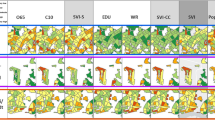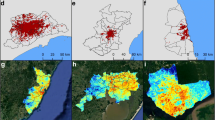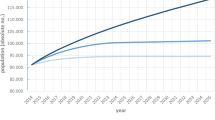Abstract
For assessing the social dimension of vulnerability, population exposure mapping is usually considered the essential starting point. Integration of social structure then further differentiates situation-specific vulnerability patterns on a local scale. Census data available in heterogeneous spatial reference units are still considered the standard information input for assessing potentially affected people, for example, in case of an emergency. There is a strong demand for population data in homogeneous spatial units that are independent from administrative areas. Raster representations meet this demand but are not yet available for all European countries. In this paper, we present an approach of spatial disaggregation of population data for a European transect referring to current population statistics and anticipated future prospects. Recently published data providing the degree of soil sealing are applied as basic proxy for population density in the spatial disaggregation model. In order to assess future patterns of climate change-related vulnerability, results of a European regional climate model are considered for projecting the situation in the 2030s. “Heat wave frequency” is accounted for as climate variable featuring conditions regarded as especially strenuous for elderly or physically weak persons. Integrated analysis of the population and climate prospects enables identification of hot spots in the European transect examined, that is, regions of particularly demanding projected climatic patterns as well as high population density and case-specific vulnerable structure (elderly people). Integrated and consistent spatial analyses on European scale are essential for decision support in the context of climate change impact mitigation as well as for risk communication and future safety and security considerations.







Similar content being viewed by others
Notes
Considered an extension and further elaboration of the explanations in Aubrecht et al. (2011b).
NUTS Nomenclature of Units for Territorial Statistics, a geocode standard of the European Union for referencing the subdivisions of countries for statistical purposes; a hierarchy of three NUTS levels is established for all EU member countries by Eurostat.
References
Adger WN (2006) Vulnerability. Glob Environ Chang 16(3):268–281
Anderson CA (1989) Temperature and aggression: ubiquitous effects of heat on occurrence of human violence. Psychol Bull 106(1):74–96
Anderson CA, Anderson KB (1998) Temperature and aggression: paradox, controversy, and a (fairly) clear picture. In: Geen R, Donnerstein E (eds) Human aggression: theories, research and implications for policy. Academic Press, San Diego, pp 247–298
Aubrecht C, Steinnocher K, Hollaus M, Wagner W (2009a) Integrating Earth observation and GIScience for high resolution spatial and functional modeling of urban land use. Comput Environ Urban Syst 33(1):15–25
Aubrecht C, Köstl M, Knoflacher M, Steinnocher K (2009b) The importance of active public communication—settlement systems and land use patterns seen from a disaster perspective. In: Schrenk M, Popovich VV, Engelke D, Elisei P (eds) Strategies. Concepts and technologies for planning the urban future, Sitges, pp 895–900
Aubrecht C, Freire S, Elvidge C, de Sherbinin A, Wegscheider S, Steinnocher K (2011a) Social vulnerability: different scales, different dimensions. Second annual conference of the international society for integrated disaster risk management—IDRiM 2011. Los Angeles, CA
Aubrecht C, Steinnocher K, Köstl M, Züger J, Loibl W (2011b) Spatially modeled high detail population and climate prospects for a European transect—an outlook to future patterns of vulnerability. In: Guarascio M, Reniers G, Brebbia CA, Garzia F (eds) Safety and security engineering IV. WIT transactions on the built environment 117. WIT Press, Southampton, UK, pp 219–232
Aubrecht C, Freire S, Loibl W, Steinnocher K, Ungar J (2012a) The contribution of multi-level geospatial information to assessing urban social vulnerability to earthquakes. In: Proceedings of the 9th CUEE and 4th ACEE Joint Conference. Tokyo, Japan
Aubrecht C, Freire S, Neuhold C, Curtis A, Steinnocher K (2012b) Introducing a temporal component in spatial vulnerability analysis. Disaster Adv 5(2), (in press)
Aunan K (2001) Global oppvarming og malariatilfeller. CICERO bakgrunnsstoff: Klimaendringer—vitenskapelig grunnlag og politiske prosesser. CICERO, Oslo
Balk DL, Deichmann U, Yetman G, Pozzi F, Hay SI, Nelson A (2006) Determining global population distribution: methods, applications and data. In: Hay SI, Graham AJ, Rogers DJ (eds) Global mapping of infectious diseases: methods, examples and emerging applications. Advances in parasitology, vol 62. Academic Press, Massachusetts, pp 119–156
Batty M (2005) Cities and complexity: understanding cities with cellular automata, agent-based models, and fractals. MIT Press, Cambridge p 565
Eicher CL, Brewer CA (2001) Dasymetric mapping and areal interpolation: implementation and evaluation. Cartogr Geogr Inf Sci 28(2):125–138
European Environment Agency (2010) EEA Fast Track Service Precursor On Land Monitoring—degree of soil sealing 100 m. Available at http://www.eea.europa.eu/data-and-maps/data/eea-fast-track-service-precursor-on-land-monitoring-degree-of-soil-sealing-100m-1. Publish date 01/26/2010. Accessed 11 July 2012
European Environment Information and Observation Network EIONET (2008) LMCS High resolution soil sealing layer. Available at http://sia.eionet.europa.eu/CLC2006/FTSP/built-up_areas. Accessed 11 July 2012
Eurostat (2008) EUROPOP2008—convergence scenario, regional level. Available at http://epp.eurostat.ec.europa.eu/cache/ITY_SDDS/de/proj_r08c_esms.htm. Accessed 11 July 2012
Finch C, Emrich C, Cutter S (2010) Disaster disparities and differential recovery in New Orleans. Popul Environ 31(4):179–202
Füssel H-M (2007) Vulnerability: a generally applicable conceptual framework for climate change research. Glob Environ Chang 17(2):155–167
Gallego FJ (2010) A population density grid of the European Union. Popul Environ 31(6):460–473
geoland project consortium (2011) EU FP-7 project geoland2: supporting the monitoring, protection and sustainable management of our environment. www.gmes-geoland.info. Accessed 11 July 2012
Giannakouris K (2008) Ageing characterises the demographic perspectives of the European societies. Population and social conditions. Statistics in focus 72/2008. Eurostat, European Commission, Luxembourg, p 12
Githeko AK, Lindsay SW, Confalonieri UE, Patz JA (2000) Climate change and vector-borne diseases: a regional analysis. Bull World Health Organ 78(9):1136–1147
Gosling SN, Lowe JA, McGregor GR, Pelling M, Malamud BD (2008) Associations between elevated atmospheric temperature and human mortality: a critical review of the literature. Clim Chang 92(3–4):299–341
Keuler K, Lautenschlager M, Wunram C, Keup-Thiel E, Schubert M, Will A, Rockel B, Boehm U (2009) Climate simulation with CLM, scenario A1B run no. 1, data stream 2: European region MPI-M/MaD. World Data Center for Climate. doi:10.1594/WDCC/CLM_A1B_1_D2
Kovats RS (2012) Global health and global environmental governance—research for policy. Glob Environ Chang 22(1):1–2
Kovats S, Akhtar R (2008) Climate, climate change and human health in Asian cities. Environ Urban 20(1):165–175
Kovats RS, Hajat S (2008) Heat stress and public health: a critical review. Annu Rev Pub Health 29(1):41–55
Kovats S, Lloyd S (2010) Population, climate and health. In: Guzmán JM, Martine G, McGranahan G, Schensul D, Tacoli C (eds) Population dynamics and climate change. UNFPA and IIED, New York, pp 164–175
Kyselý J (2004) Mortality and displaced mortality during heat waves in the Czech Republic. Int J Biometeorol 49(2):91–97
Kyselý J, Huth R (2004) Heat-related mortality in the Czech Republic examined through synoptic and “traditional” approaches. Clim Res 25(3):265–274
Kyselý J, Kalvová J, Kveton V (2000) Heat waves in the South Moravian Region during the period 1961–1995. Stud Geophys Geod 44(1):57–72
Langford M (2007) Rapid facilitation of dasymetric-based population interpolation by means of raster pixel maps. Comput Environ Urban Syst 31(1):19–32
Lautenschlager M, Keuler K, Wunram C, Keup-Thiel E, Schubert M, Will A, Rockel B, Boehm U (2009) Climate simulation with CLM, climate of the 20th century run no. 1, data stream 2: European region MPI-M/MaD. World Data Center for Climate. doi:10.1594/WDCC/CLM_C20_1_D2
McLeman R (2010) Impacts of population change on vulnerability and the capacity to adapt to climate change and variability: a typology based on lessons from “a hard country”. Popul Environ 31(5):286–316
McMichael AJ, Woodruff RE, Hales S (2006) Climate change and human health: present and future risks. Lancet 367(9513):859–869
Mennis J, Hultgren T (2006) Intelligent dasymetric mapping and its application to areal interpolation. Cartogr Geogr Inf Sci 33(3):179–194
Nakicenovic N, Swart R (2000) IPCC special report—emissions scenarios: summary for policymakers. IPCC, Geneva p 20
Plyer A (2010) Neighborhood recovery rates—resiliency of new Orleanais shown in neighborhood repopulation numbers. Greater New Orleans Community Data Center, p 5
Robine J-M, Cheung SLK, Le Roy S, Van Oyen H, Griffiths C, Michel J-P, Herrmann FR (2008) Death toll exceeded 70,000 in Europe during the summer of 2003. C R Biol 331(2):171–178
Rockel B, Will A, Hense A (2008) The regional climate model COSMO-CLM (CCLM). Meteorol Z 17(4):347–348
Roeckner E, Brokopf R, Esch M, Giorgetta M, Hagemann S, Kornblueh L, Manzini E, Schlese U, Schulzweida U (2006) Sensitivity of simulated climate to horizontal and vertical resolution in the ECHAM5 atmosphere model. J Clim 19(16):3771–3791
Rotton J (1986) Determination redux: climate and cultural correlates of violence. Environ Behav 18:346–368
Schubert M (2007) CLM Konsortial-simulations at the model and data group (M&D). CLM Community-Assembly, Langen p 3
Sheridan SC, Kalkstein AJ (2010) Seasonal variability in heat-related mortality across the United States. Nat Hazards 55(2):291–305
Smoyer-Tomic KE, Kuhn R, Hudson A (2003) Heat wave hazards: an overview of heat wave impacts in Canada. Nat Hazards 28(2–3):465–486
Steinnocher K, Weichselbaum J, Köstl M (2006) Linking remote sensing and demographic analysis in urbanised areas. In: Hostert, Damm, Schiefer (eds) 1st EARSeL workshop of the SIG urban remote sensing, challenges and solutions. Berlin, p 8
Steinnocher K, Köstl M, Weichselbaum J (2011) Grid-based population and land take trend indicators—new approaches introduced by the geoland2 core information service for spatial planning. New techniques and technologies for statistics. NTTS 2011. Brussels, p 9
Sutherst RW (2001) The vulnerability of animal and human health to parasites under global change. Int J Parasitol 31:933–948
Vaneckova P, Hart MA, Beggs PJ, Dear RJ (2008) Synoptic analysis of heat-related mortality in Sydney, Australia, 1993–2001. Int J Biometeorol 52(6):439–451
Acknowledgments
Part of the study was performed within the Core Information Service for Spatial Planning of the project geoland2 (http://www.gmes-geoland.info/) in the frame of the GMES (Global Monitoring for Environment and Security) initiative. The project geoland2 is a Collaborative Project (2008–2012) funded by the European Union under the 7th Framework Programme (project number FP-7-218795).
Author information
Authors and Affiliations
Corresponding author
Rights and permissions
About this article
Cite this article
Aubrecht, C., Steinnocher, K., Köstl, M. et al. Long-term spatio-temporal social vulnerability variation considering health-related climate change parameters particularly affecting elderly. Nat Hazards 68, 1371–1384 (2013). https://doi.org/10.1007/s11069-012-0324-0
Received:
Accepted:
Published:
Issue Date:
DOI: https://doi.org/10.1007/s11069-012-0324-0




